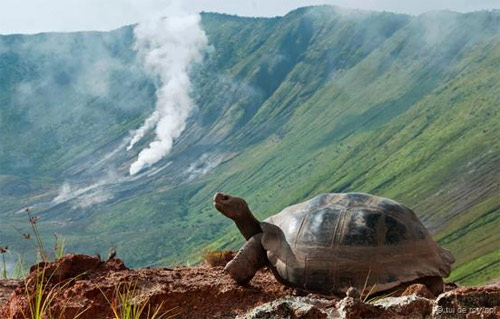Discover the unknown about the world's largest tortoise turtle
It is thought that the age of turtles can be determined by studying growth rings in the shell, but in fact, this is difficult unless it is known when they hatch the eggs.
Unknown things about the world's largest tortoise turtle
The world's largest tortoise turtle is now found in the Seychelles Republic - an island nation on the Indian Ocean , and the Galápagos Islands in the Pacific Ocean . This is the reason why many people think that their large size is formed from the island's habitat. However, this is not entirely certain.

A Galápagos turtle.(Photo: Tui De Roy / NPL)
A large species of turtle with the scientific name Hesperotestudo crassiscutata used to exist in Central America and southern America, but extinct 12,000 years ago. Queensland, Australia used to be home to the " monster" turtles Ninjemys oweni. Siwaliks (Megalochelys atlas) is present in the region of India today several million years ago, about twice the size of the Galápagos turtle . According to a genetic analysis in 1999, the ancestors of the Galápagos turtle were larger than their current size.
According to the International Union for Conservation of Nature (IUCN) study, many giant turtles once existed on the planet, but they have a higher extinction rate than small or medium species.
Anders Rhodin, director of the Turtle Research Organization (CRF), said the slow and less threatening animals are easy to find. Because they can exist without food or water for long periods of time, they can be stored as alive, becoming a source of food for months. Rhodin likens turtles like canned food and hominins to use stone tools to "open the lid".
It is thought that the age of a turtle is determined by counting growth rings on tortoise shells. However, this method is only reliable in the first or second year, is not effective for adults. The exact age determination is based on the number of turtles laid and incubated. In some cases, experts determine there are turtles that live 150 years or more.

A giant tortoise can be unusually smart.(Photo: Tui De Roy / NPL)
In 1835, Charles Darwin once considered the giant tortoise in the Galápagos to move faster than he had imagined, going 6.4 km / day and having a short respite. By means of tracking devices, modern scientists show that they mainly perform short movement steps, traveling no more than 2 km / day.
According to experts, although slow, turtles can be quite smart . In the study of South American red-footed tortoises (relatives of giant turtles in the Galápagos), they found that they used landmarks to set up a map of their surroundings. This reptile can also learn the behavior of other animals.
- Secretly dress 99 nooks and death of turtle tools
- Giant tortoise took over the position of mother at the age of 80
- Tomorrow tortoise is not to do something like you think
- Discover the shocking about turtle shells
- Discover the world's longest-lived turtle
- 13 facts about turtles that few people know about
- Monster turtles have the most horror form on the planet
- The oldest tortoise in the world can be gay
- The phenomenon of a belly-backed turtle turns itself over
- Turtles survive in closed rooms for more than 30 years
- The untold story about the turtle skeleton in Yen Bai and Hoa Binh
- Scientific identifier for Tortoise tool: Le Loi or Vietnam?
 Animal 'suffering' after hibernation
Animal 'suffering' after hibernation Why do goats climb well?
Why do goats climb well? Scientists were surprised to see chimpanzees eating turtles
Scientists were surprised to see chimpanzees eating turtles Giant catfish died deadly due to drought in Thailand
Giant catfish died deadly due to drought in Thailand